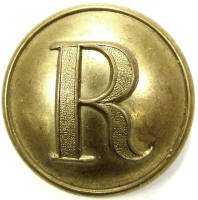
A virtual examination of artifacts of the American Civil War
 |
Ridgeway Civil War Research Center, A virtual examination of artifacts of the American Civil War |
| Civil War Artillery | |
| by Harry Ridgeway |
| Rifled artillery projectile, Tennessee design, Confederate manufacture, solid bolt, short pattern with round nose, bourrelet rings, copper disc cupped sabot with 3 studs in the sabot, rifled 32 pounder or Brooke rifle, 6.4in. Projectile was Confederate manufactured and was originally believed to have been developed by Mullane working with Read and others, however, updated research has not been able to confirm the existence of a man named Mullane. Period literature often refers to work as the "Tennessee" design, cup, or sabot, and is attributed to Captain Lardner Gibbon, although official recognition for his development was never granted. The sabot system utilized was a copper disc held in place by studs and secured with a center bolt, a manufacturing innovation allowing the parts made of different metals, copper and iron, to be prepared independent and assembled at the end. This sabot pattern, referred to as Type II, employed three studs cast into the sabot and fitted into holes cast into the shell body, secured by a bolt in the center. This pattern utilized two bourrelet rings, as a labor saving device, only the rings had to be accurately machined, the rest could be left rough , the top is rounded, it was designed to be used against the Federal ironclads, but was probably judged ineffective, most bolts developed by the Confederacy employed flatter surfaces on top. This relatively short bolt was likely intended for the old 32 pounder smoothbores that had been banded and converted to rifled. Projectile measures: diameter 6.35in., length 11.4in., 10in. without sabot, weight 68lbs. Research Center: Artillery5881-Tennessee, Ref: Bell, Heavy Ordnance, pg. 412 & 413. Details click: http://relicman.com/artillery/Artillery5881-Tennessee.html. |
| Ridgeway Civil War Research Center, A virtual examination of artifacts of the American Civil War. Artillery Research center, artillery, click: http://relicman.com/artillery/Artillery0000-Index.html. Research center, artillery, click: http://relicman.com/artillery/Artillery0000-Index.html. |
| Civil War Relicman, Harry Ridgeway, Civil War artillery, Relicman sales catalog. Click here: http://relicman.com/artillery/RelicmanSalesArtillery1.html. Artillery for sale: http://relicman.com/artillery/RelicmanSalesArtillery1.html. |